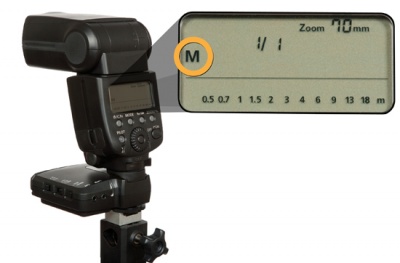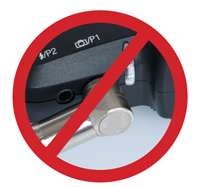Difference between revisions of "Manual Flash"
| Line 1: | Line 1: | ||
{{recommended reading|HyperSync|}} | {{recommended reading|HyperSync|}} | ||
| + | A transmitting MiniTT1 or FlexTT5 can trigger any receiving PocketWizard, including flashes with built-in PocketWizards. They can transmit on any of the 32 PocketWizard Standard Channels and a receiving FlexTT5 can be used with MultiMAX zones. You can even trigger E-TTL and manual flashes together. | ||
| + | |||
| + | [[File:manualspeedlite.jpg|400px|thumb|right|A 580EX II in manual mode.]] | ||
| + | ===Triggering Hot Shoe Flashes Manually=== | ||
| + | |||
| + | Slide a Speedlite or other manual flash into the top shoe of a FlexTT5 for manual triggering without cords. You can also use a manual flash in the top shoe of an on-camera MiniTT1 or FlexTT5. No configuration of the radio is necessary. | ||
| + | |||
| + | |||
| + | ===Triggering Studio Strobes=== | ||
| + | You can use a receiving FlexTT5 to trigger studio strobes. Use our [http://www.pocketwizard.com/support/cable_finder/ Cable Finder] to find the right cable for lots of different strobes. | ||
| + | |||
| + | |||
| + | If you’re using a PocketWizard Plus, Plus II, or MultiMAX as a transmitter, be sure to set the FlexTT5 to receive on a Standard Channel. This can be set in the PocketWizard Utility or while shooting on-location via Learn Mode. See the tutorial on Learn Mode here. | ||
| + | |||
| + | If you are using a Sekonic Meter that incorporates a transmitter to trigger flashes and a FlexTT5 as a receiver, be sure to set the FlexTT5 to receive a Standard PocketWizard signal. You can use the method above if a Standard PocketWizard radio is being used as a transmitter. If you are using a MiniTT1 or another FlexTT5 as a transmitter, use the PocketWizard Utility to set the FlexTT5 to receive a Standard PocketWizard signal as shown in "Using the PocketWizard Utility". | ||
| + | |||
| + | |||
| + | |||
| + | '''Note:''' Do not connect a flash to the camera port (P1) on a FlexTT5. You could damage your radio. This port is for triggering Canon motor drives only and isn’t designed for the trigger voltages used by some flashes. | ||
| + | [[File:nop1port.jpg|400px|thumb|left]] | ||
Revision as of 10:53, 29 August 2011
| Next recommended reading: HyperSync |
A transmitting MiniTT1 or FlexTT5 can trigger any receiving PocketWizard, including flashes with built-in PocketWizards. They can transmit on any of the 32 PocketWizard Standard Channels and a receiving FlexTT5 can be used with MultiMAX zones. You can even trigger E-TTL and manual flashes together.
Triggering Hot Shoe Flashes Manually
Slide a Speedlite or other manual flash into the top shoe of a FlexTT5 for manual triggering without cords. You can also use a manual flash in the top shoe of an on-camera MiniTT1 or FlexTT5. No configuration of the radio is necessary.
Triggering Studio Strobes
You can use a receiving FlexTT5 to trigger studio strobes. Use our Cable Finder to find the right cable for lots of different strobes.
If you’re using a PocketWizard Plus, Plus II, or MultiMAX as a transmitter, be sure to set the FlexTT5 to receive on a Standard Channel. This can be set in the PocketWizard Utility or while shooting on-location via Learn Mode. See the tutorial on Learn Mode here.
If you are using a Sekonic Meter that incorporates a transmitter to trigger flashes and a FlexTT5 as a receiver, be sure to set the FlexTT5 to receive a Standard PocketWizard signal. You can use the method above if a Standard PocketWizard radio is being used as a transmitter. If you are using a MiniTT1 or another FlexTT5 as a transmitter, use the PocketWizard Utility to set the FlexTT5 to receive a Standard PocketWizard signal as shown in "Using the PocketWizard Utility".
Note: Do not connect a flash to the camera port (P1) on a FlexTT5. You could damage your radio. This port is for triggering Canon motor drives only and isn’t designed for the trigger voltages used by some flashes.

